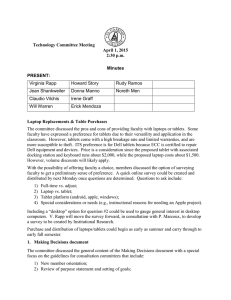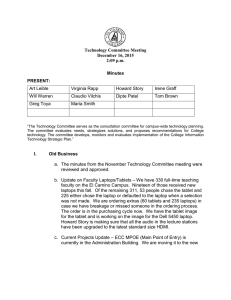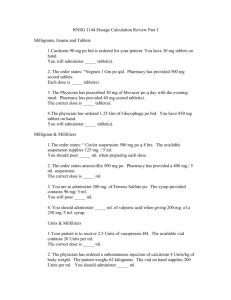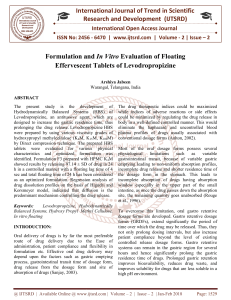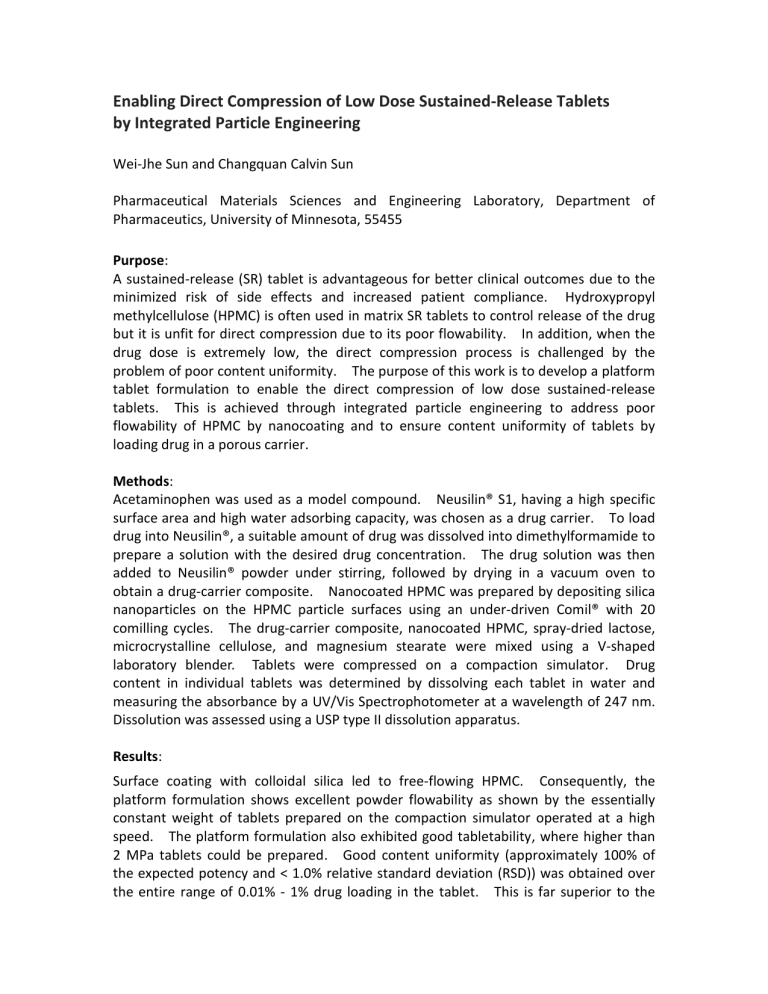
Enabling Direct Compression of Low Dose Sustained-Release Tablets by Integrated Particle Engineering Wei-Jhe Sun and Changquan Calvin Sun Pharmaceutical Materials Sciences and Engineering Laboratory, Department of Pharmaceutics, University of Minnesota, 55455 Purpose: A sustained-release (SR) tablet is advantageous for better clinical outcomes due to the minimized risk of side effects and increased patient compliance. Hydroxypropyl methylcellulose (HPMC) is often used in matrix SR tablets to control release of the drug but it is unfit for direct compression due to its poor flowability. In addition, when the drug dose is extremely low, the direct compression process is challenged by the problem of poor content uniformity. The purpose of this work is to develop a platform tablet formulation to enable the direct compression of low dose sustained-release tablets. This is achieved through integrated particle engineering to address poor flowability of HPMC by nanocoating and to ensure content uniformity of tablets by loading drug in a porous carrier. Methods: Acetaminophen was used as a model compound. Neusilin® S1, having a high specific surface area and high water adsorbing capacity, was chosen as a drug carrier. To load drug into Neusilin®, a suitable amount of drug was dissolved into dimethylformamide to prepare a solution with the desired drug concentration. The drug solution was then added to Neusilin® powder under stirring, followed by drying in a vacuum oven to obtain a drug-carrier composite. Nanocoated HPMC was prepared by depositing silica nanoparticles on the HPMC particle surfaces using an under-driven Comil® with 20 comilling cycles. The drug-carrier composite, nanocoated HPMC, spray-dried lactose, microcrystalline cellulose, and magnesium stearate were mixed using a V-shaped laboratory blender. Tablets were compressed on a compaction simulator. Drug content in individual tablets was determined by dissolving each tablet in water and measuring the absorbance by a UV/Vis Spectrophotometer at a wavelength of 247 nm. Dissolution was assessed using a USP type II dissolution apparatus. Results: Surface coating with colloidal silica led to free-flowing HPMC. Consequently, the platform formulation shows excellent powder flowability as shown by the essentially constant weight of tablets prepared on the compaction simulator operated at a high speed. The platform formulation also exhibited good tabletability, where higher than 2 MPa tablets could be prepared. Good content uniformity (approximately 100% of the expected potency and < 1.0% relative standard deviation (RSD)) was obtained over the entire range of 0.01% - 1% drug loading in the tablet. This is far superior to the physical mixtures (70% - 175% of the expected potency and 3.6% - 34.0% RSD over the same range of drug loading). The platform tablet formulation, enabled by integrated particle engineering, is suitable for manufacturing low dose sustained-release tablets using the direct compression process. The sustained release behaviors of these tablets were confirmed by dissolution data. Conclusion: We have developed a platform direct compression tablet formulation, through integrated particle engineering, to enable the manufacture of low dose SR tablets with superior content uniformity and manufacturability. This novel platform DC formulation is robust and has the potential to expedite the development of high quality SR tablet products using the economical DC process.

